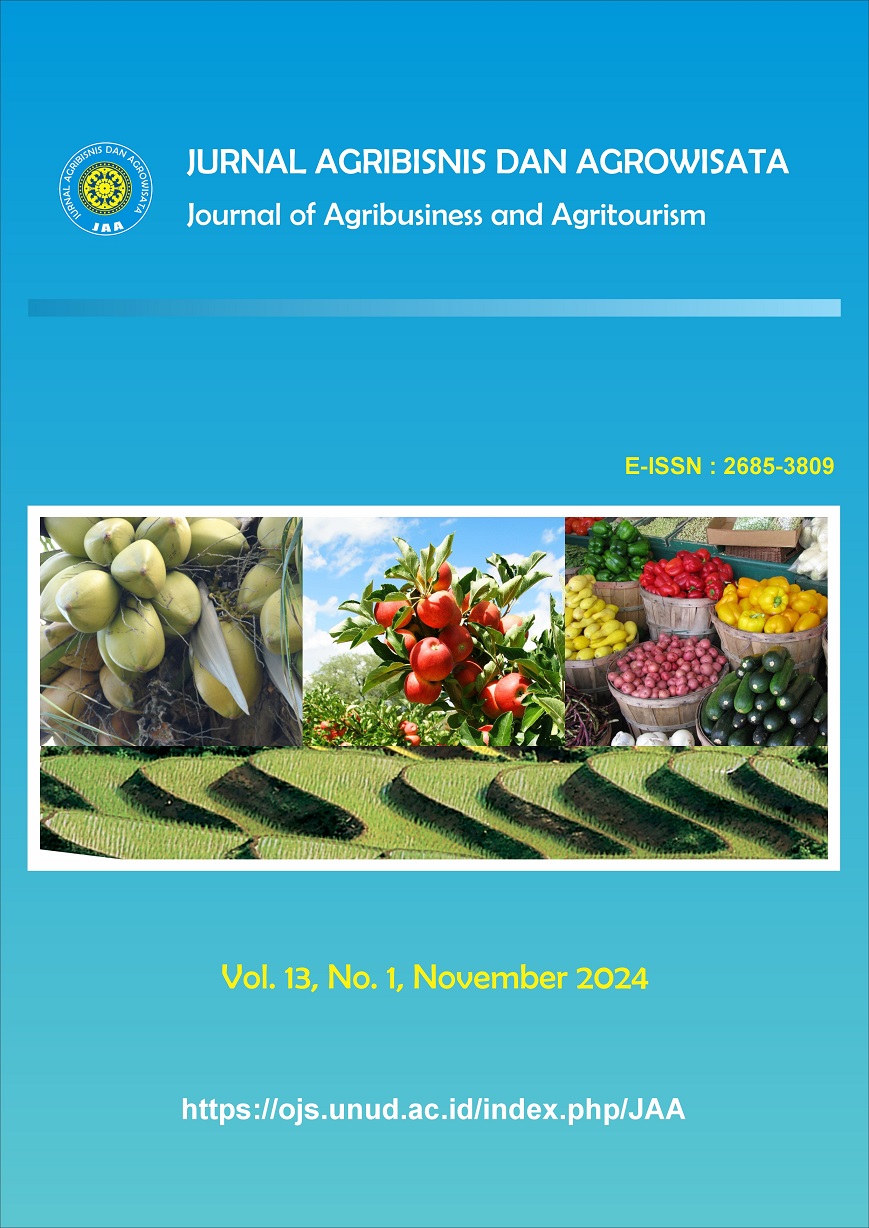Saluran, Marjin, dan Efisiensi Pemasaran Jamur Tiram di Kota Denpasar
Abstract
Channels, Margin, and Marketing Eficiency of Oyster Mushroom in Denpasar City. Oyster mushrooms are a non-seasonal horticultural commodity that can be relied upon in the Denpasar city and can be cultivated because they require a narrow planting medium, thus having a high level of productivity. There is a price gap between what farmers receive and what end consumers pay. The purpose of this research to analyze the marketing channels of oyster mushroom carried out by farmers and marketing institutions in the Denpasar city, as well as to analyze marketing efficiency based on marketing margins and farmer's share. The quantitative data of this study include marketing efficiency, marketing margins, and farmer's share. Qualitative data in this study include marketing channel patterns. The respondents in this study were 25 people, farmers. The sample of this study was determined by the method of saturated sampling for oyster mushroom farmers, while marketing institutions were determined using snowball sampling. The results showed that the marketing patterns consisted of three marketing, consissting of (I) farmers - consumers, (II) farmers - retailers - consumers, and (III) farmers - restaurants - consumers. In marketing channel I, the marketing margin is Rp 0 and the farmer's share is 100%. In marketing channel II, the marketing margin is Rp 12,000 and the farmer's share is 62.5%. In marketing channel III, the marketing margin is Rp 66,000 and the farmer's share is 23.2%. Based on the calculation of efficiency values, different efficiency values were obtained where the efficiency value of marketing channel I is 0%, marketing channel II is 11.7%, and marketing channel III is 36.5% .Oyster mushroom farmers should prioritize distributing oyster mushrooms through channel II to become the most efficient marketing channel to gain higher profits.
Downloads
References
Asmarantaka RW. 2014. Pemasaran Agribisnis (Agrimarketing). Bogor: Institut
Deepalakshmi, K., dan Sankaran, M. 2014. Pleurotus ostreatus: an oyster mushroom with nutritional and medicinal properties. Journal of Biochemical Technology, 5(2), 718-726.
Simorangkir, N. C., & Rosiana, N. 2022. Analisis efisiensi pemasaran kopi robusta. Jurnal Agribisnis Indonesia (Journal of Indonesian Agribusiness), Volume 10 Nomor 1.
Sudana, I. W.2019. Analisis Efisiensi Pemasaran Ikan Teri Segar Hasil Tangkapan Nelayan di Desa Sanggalangit Kabupaten Buleleng. Jurnal Pendidikan Ekonomi, 11(2), 2599-1426.
Sugiyono. 2012. Metode Penelitian Kuantitatif, Kualitatif dan R&D. Bandung:Alfabeta Bandung.
Suharyanto, Ida Ayu Putu Parwati dan Jemmy Rinaldi. 2005. Analisis Pemasaran dan Tataniaga Anggur di Bali. Jurnal Sosial Ekonomi Pertanian dan Agribisnis (SOCA), Volume 8 Nomor 1, Februari 2008. Denpasar.
Wibowo, B. T., Yurisinthae, E., & Fitrianti, W. 2022. Analisis Efisiensi Pemasaran Jamur Tiram Di Kota Pontianak. Jurnal Ekonomi Pertanian dan Agribisnis, 6(4), 1281-1290.
Wuryantoro, W., & Candra, A. 2021. Analisis Margin Pemasaran Agroindustri Beras di Kota Mataram. Agrimansion, Volume 22 Nomor 1.
Zainuddin, K. E. 2017. Buku Ajar Pemasaran Produk Agribisnis.
Zulkamain. 2010. Dasar-dasar Hortikultura. Jakarta: PT Bumi Aksara.







